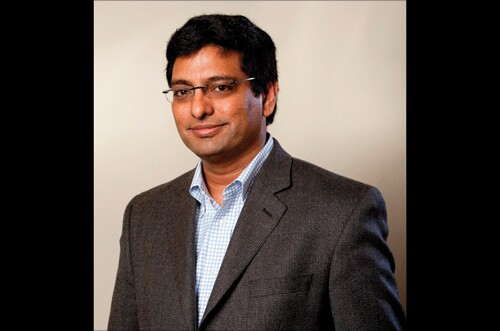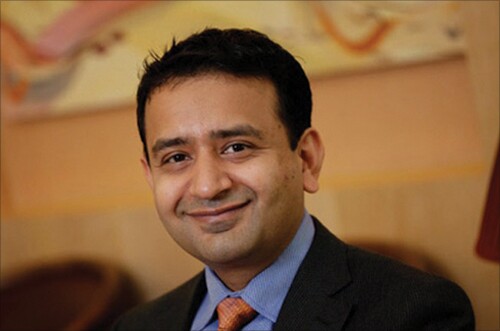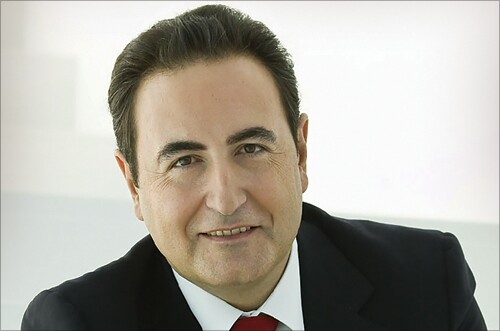
For the full list of the FinTech Top 100,

FIS Pioneers Mobile Payment Tech
Mobile offerings have evolved from very simple deployments in 2007 and 2008, to the point where today, many mission-critical applications in financial services have become mobile-able, Norcross says.
The company has also had a lot of growth around its emerging payments capabilities. Reloadable praid cards have become mobile enabled and even de facto demand accounts, he says.
Last year, FIS launched PayNet Real-Time Payments Network, which claims to be the first real-time payments network for both retail and commercial trade.
"We're already running hundreds of thousands of transactions a quarter through that network," Norcross says. "We think that could be a aningful provider of revenue growth over the next two or three years."
Also, in February the company launched its real-time person-to-person payment product, PeoplePay, which financial institution customers can brand without having to join a proprietary network.
Of the company's 37,000-plus employees, 22,000 are in services and the rest are tied to product development, deoyment and other areas. About 20 percent of the company's revenues come from outside of North America, with 68 percent from North America and 12 percent in North America but tied to non-financial institutions.
The company performed well in North America, where the business climate continued to improve from the 2008 and 2009 economic downturn, and in international markets, where FIS had double-digit growth. The company also saw strong growth in Europe, chiefly with its consulting business.
FIS recently signed its largest contract in Asia, with India-owned banks, to deploy ATMs to provide "financial inclusion" to the country's poor over the next four years. The contracts should generate more than $100 million per year for FIS, Norcross says.

TCS Puts Hopes in the Cloud
First, banks are searching for more ways to improve their efficiency, and coming out of the fiscal crisis they feel pressured to do so, Krithivasan said. Those efficiencies migt come from creating shared services, automation, re-engineering their processes or consolidating their vendors.
Generally, European banks seem to have a greater need to reduce costs, and they are taking more interest in offshoring and outsourcing as ways to improve their operational efficiency, he says.
The second factor driving growth is the advent of new digital technogies in the market that provide banks with the opportunity to enhance the customer experience, Krithivasan says. Those technologies include or are related to mobile devices, social media, analytics, artificial intelligence and cloud computing.
The third factor is the increase in risk management and regulatory reporting related to fallout from the financial crisis and a tighter regulatry environment, Krithivasan said.
TCS, which already has a cloud-based banking solution in Europe and India, plans to roll out a similar product in the U.S. In July, TCS announced that it was partnering with Savvis to provide the Banking Solution, or BaNCS, for small banks and credit unions in the U.S.
The BaNCS platform includes core banking, payments, compliance, corpore actions and insurance covering property and casualty, life and annuities. It allows banks to configure the solution and IT infrastructure to their individual needs, improving on their cost per transaction.
Company executives see great potential with mid-sized and small banks for the cloud-based solution. TCS also plans to increase its focus on emerging market countries in Latin Amerca, South Africa and the Middle East, where it sees banks undergoing a major transformation, Krithivasan said.

Fiserv Pursues Payment Innovation
"These things have long tails to them, which means wthink there are going to be several years of significant growth in the amount of innovations going on in the payment field today -- it's unprecedented, as far as we can see," says Mark Ernst, Fiserv's chief operating officer.
The company, which serves nearly 5,200 institutions with its core processing technology, acquired Open Solutions and its core processing platforms, along ith about 400 clients, in January 2013.
Banks are responding to consumer demand for consistent experience and capabilities across platforms, including smartphones, tablets and online banking, Ernst says. One example would be adding a new biller to a bill payment program using the same method on a tablet as with a PC.
Fiserv has developed mobile banking software that can be delered in licensed form to banks that want to modify the code for their individualized use and in an ASP format for smaller banks. Fiserv launched ASP software for tablets in 2012.
Fiserv announced the availability of real-time capability for person-to-person payments in its Popmoney program in April. Popmoney, which has nearly 2,000 bank and credit union users, launched with a one-day r multi-day lag, about two years ago.
Another area with growth potential for Fiserv is helping financial institutions access and use client data, under the so-called big data umbrella, to tailor best offers to individual clients with the optimum timing and to combat fraud, Ernst says.

NCR Shifts to Software
"It is the fastest growing area of our business and we want to build on that to help banks meet their objectives," says Andrew Heyman, senior vice president and general manager. "New software platforms will help unlck the full potential for banks as they re-engineer their branches and mobile footprint."
NCR has been building its software business through acquisitions, including Radiant Systems in 2011; Retalix and Transoft International, the cash management software company, in 2012; and uGenius Technologies in January.
uGenius is a key element of NCR's Interactive Services solution meant to help banks improve productivity and increase revenue through assisted service, Heyman says.
Over the past 24 months, the company has spent nearly $2 billion on software-related acquisitions, and it plans more acquisitions over the next several years.
In 2014, retail banks will leverage mobile technologies for their customers and staff to make everyday transactions eaer, he says. "I see 2014 as the most important year for NCR since the middle of the last decade when we began our re-invention.
This year, NCR has sold nearly 10,000 security solutions targeting skimming. Last year, it introduced APTRA Interactive Services, installed at more than 60 banks and credit unions in the U.S. APTRA Interactive Teller lets live tellers remotely control the AT to talk with and conduct transactions with consumers via video. The technology could be applied to smart phones, Heyman says.

Mobile, Cloud, Social Drive Cognizant
Those include technologies to engage their customers with mobile platforms, to leverage cloud solutions, for social media, to look at the emergence of big data and unstructured data, and to use analytics to cross-sell and enhance the customer experience, Chintamaneni says.
Banking and financial services is Cognizant's largest industry practice; the sector continues to focus on cost optimization in the wake of the 2008 and 209 financial crisis, Chintamaneni says. In the low interest rate environment, cost optimization is one way these companies can maintain earnings growth or invest in change.
"We're helping banks with a multitude of initiatives," he says. "They're all aligned around the bank of the future."
Banks have found themselves in a back-to-basics environment, Chintamaneni says. "If you dot leverage mobility and differentiate your offerings and products and services, it is hard for you to appear different from a bank across the street.
"The smarter banks have been going beyond legacy technology and embracing new technologies in an accelerated timeframe, so that they appear differentiated and evolved," he says.
Risk management and regulatory compliance initiative that require action, usually by a certain deadline, have been another driver of business for Cognizant.
Dodd-Frank, the Foreign Account Tax Compliance Act and Basel III banking standards top the list of compliance concerns, along with evolving credit card transaction standards.

Diebold Helps Banks Rethink Branches
"We've been on a journey here where we think about, primarily, process efficiency, transaction efficiency, security, reliability <97> all those things that are important when you automate transactions," Natoli says.
"For the past couple of years, we've been integrating that with a focus on the consumer," he says.
Diebold has incorporated the consumer-centric point of view in a new branch delivery model, deployed at the University Federal Credit Union in Austin, Texas, that takes on the feel of an Apple store, Natoli says. Diebold has also launched concierge video services, using video at ATMs to deliver more personalized self-service transactions.
"Our job is to connect banks and financial institutions with their customers in a way that simplifies and enhances the experience for both parties," Natoli says.
In 2012, in North America, upgrades required by the ADA (Americans with Disabilities Act) and PCI (Payment Card Industry) compliance deadlines were big revenue generators for Diebold, Natoli says. Those upgrades also led to a lot of deposit automation technology projects.
Because almost all ATMs use Windows software, banks will have to make upgrades before Windows XP is phased out in 2014, Natoli said. Diebold partnered with U.S. Bank to deploy the first ATM operating on Windows 7. EMV card transaction standards will also require U.S. banks to upgrade their systems.

SunGard Ponders Pervasive Computing
SunGard has more than 17,000 employees, with about 25,000 customers in 70 countries.
Risk and regulatory issues include uncertainover implementation of legislation like the Dodd-Frank Act and international Basel III bank standards, he says.
For large banks, a regulatory concern ripe for automation is the so-called "living will" requirement under Dodd-Frank, in which they submit plans, updated annually, for an orderly unwinding if financial catastrophe strikes. The European Union and U.K. have similar requiremens.
"The business case is very clear: They're spending $2 million a year on armies of people to come in and capture data and update mundane documents, versus maintaining it in a central depository that you maintain electronically," Wallis says. "It's an obvious return on investment."
Another area with great potential is "pervasive" computing, which incorporates the expansion ofobile device use by bank customers, Wallis says.
"How does the use of pervasive computing technology -- including smart phones, tablets, web-based services, and ATM networks -- affect the ability to serve a customer, and how that can be used to gain a competitive advantage," he says.
The "data as a currency" concept also is an area with great potential, Wallis says. Acustomers are willing to give up information about themselves -- their GPS location to a restaurant, for example -- businesses can use technology to build new interactions that will help win new customers and retain them.

Infosys Sees Expansion of Outsourcing
One trend is "industrialization," with banks looking closely at their technology spending and eliminating unnecessary costs and risks, Joshi says. That may include replacing bespoke internal systems with outsourced application platforms and simplifying application portfolios by cutting duplicate programs from the 5,000 to 8,000 tht are typical for a large bank.
"Banks have such a complex array of applications, this is really an attractive option for them to reduce costs and reduce risk because the more applications you have, the more risk you're potentially getting," Joshi says.
Infosys has been working on application decommissioning projects with banks, categorizing their applications by importance, building business cases describing the cost savings and risk reductions of removals and developing plans to decommission software, Joshi says.
Another key spending trend for banks is in digital technologies, including social media, big data and mobile devices. One example of Infosys' work in this area: it plans to leverage its experience developing a mobile payment network for customers of India's largest telephone company to build other mobile payment networks, Joshi says.
The third key spending trend for banks is reducing infrastructure costs through optimization and consolidation, including the use of cloud solutions. And the fourth key trend is regulatory compliance.On the regulatory front, Infosys has been working with European banks to develop technology comply with new rules on the online selling of investment products.

NRI Picks Up Market Share in Japan
In 2012, the most significant event for the company may have been when Nomura Securities adopted NRI's Star settlement system, which made NRI the de-facto provider of such systems in Japan, says Yasuki Okai, financial technology solution division manager at NRI. While Star already had a big share of the market with small and medium securities companies, signing one of Japan's largest cleared the way for other top-tier securities firms.
Nomura Research Institute's biggest revenue generator is financial technology, which accounts for about 70 percent of the company's total revenue. Nomura has dominant market share in Japan for certain buyside and sellside accounting systems.
Another opportunity Nomura Research Institute capitalized on in 2012 was the adoption of business process outsourcing (BPO) for asset managers and insurance companies in Japan, as they look to reduce cost and inefficiencies.
While most of NRI's clients are based in Japan, the company's goal this year and in 2014 is to help its Japan clients go outside Japan, through mergers and acquisitions or business expansion.
"If we can show that we have capability to support them, to support their overseas business, then we believe that there are a lot of opportunities for us," he says.
Another goal is to help global companies expand into Japan, like NRI's collaboration with UBS, announced in September, to offer middle- and back-office solutions for Japanese broker-dealers seeking to expand, Okai says.
Wincor Nixdorf Sees Life in ATMs
"Consumers today want to have 24/7 access to banking services, and want to choose when and how to interact with the bank, which channel to use," Lopez-Bartolome says.
"Therefore, the branch, the ATM and the new mobile environment are part of a singular new opportunity for companies that supply these to banks who know the industry and know the realities for consumers."
Wincor Nixdorf, with about 9,000 employees, considers itself the second-leading seller in the world of both programmable electronic point of sale (EPOS) systems and automated teller machines.
After restructuring its operations last year, Wincor Nixdorf reports that it has become more customer focused.
"We have to continue investing in R&D in new hardware technologies," Lopez-Bartolome says. "Banks are expanding the use of self service in branches and ATMs."In September, Wincor Nixdorf announced the launch of its software headquarters in The Netherlands, near Amsterdam, where software for retail banks, retailers and professional services will be managed.






